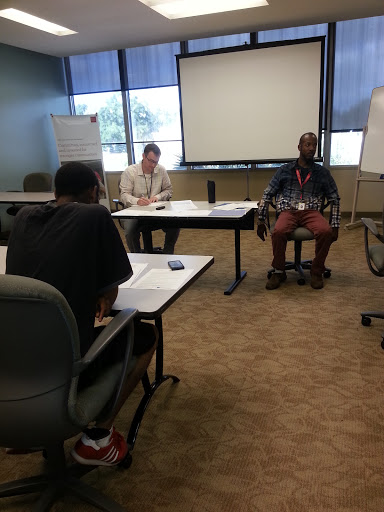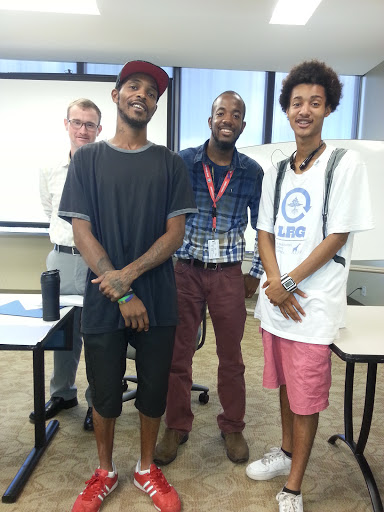Infant Mortality: A Reality for Dads Too
 Being that September is Infant Mortality Awareness Month, organizations in Duval County have been busy spreading the word on the infant mortality rate in Jacksonville. Firstly, the Northeast Florida Healthy Start Coalition kicked off the month with an infant mortality awareness press conference at the Azalea Project, which serves substance-using women. Secondly, FDOH-Duval(my host site) constructed a team to deliver infant mortality focus groups with the goal of reaching each demographic that’s affected by the infant mortality rate in Duval, from young mothers, to the elderly, to fathers! The main purpose of the focus groups was to gauge the attitudes, beliefs, and feelings of the most affected population in the community in order to effectively create public health campaigns and interventions to combat the death rate of babies before the age of 1 in Duval County.
Being that September is Infant Mortality Awareness Month, organizations in Duval County have been busy spreading the word on the infant mortality rate in Jacksonville. Firstly, the Northeast Florida Healthy Start Coalition kicked off the month with an infant mortality awareness press conference at the Azalea Project, which serves substance-using women. Secondly, FDOH-Duval(my host site) constructed a team to deliver infant mortality focus groups with the goal of reaching each demographic that’s affected by the infant mortality rate in Duval, from young mothers, to the elderly, to fathers! The main purpose of the focus groups was to gauge the attitudes, beliefs, and feelings of the most affected population in the community in order to effectively create public health campaigns and interventions to combat the death rate of babies before the age of 1 in Duval County.
Data released in 2015 from the NE FL Healthy Start Coalition’s annual Project IMPACT states that in Duval, Clay, Nassau, and St. John’s Counties, “A total of 143 babies died before their first birthdays in 2014, bringing the infant mortality rate to 8 per 1,000 live births. That figure exceeds the state rate of 6 per 1,000 and the national rate of 6.1 per 1,000. Duval had the highest rate of 8.8, while Nassau had the lowest with 5.4.” (Duvall, 2015) Duval County having the highest infant mortality rate in the Jacksonville area is a disparaging statistic, but the race disparity between White and Black babies is even more alarming; the infant mortality rate is three times higher amongst Black babies in Duval County. Why is that?
I facilitated the infant mortality focus groups for the group of fathers who volunteered to participate through the Fatherhood P.R.I.D.E initiative of the NE FL Healthy Start Coalition. To maintain the integrity of the focus group’s confidentiality, I will not identify any of the fathers by name or express any of their individual attitudes, feelings, or beliefs about infant mortality, but relinquish a general consensus of their perspectives. “Why does this racial difference exist?” was the first question I had asked, referring to the disparity in mortality rates. (Wilson, 2017). All of the fathers agreed directly and indirectly that racism, amongst other factors like access to care, education, and poverty played a huge role in this disparity. Even so, that racism is the mechanism behind many of these factors in the first place. It is easy for public health administrators, private doctors, and the general public to simply address the need for more access to prenatal care for underserved Black pregnant women. However, what about the successful Black pregnant women who are doctors or lawyers themselves, that have access to prenatal care, yet still experience infant mortality? A study found that “even black women with advanced degrees—doctors, lawyers, MBAs—were more likely to lose infants than white women who hadn’t graduated from high school.” (Carpenter, 2017).
 All of the fathers that participated in this infant mortality focus group were Black men. I asked them, “Do you think the absence of fathers in the Black community affects the infant mortality rate”? I received a passionate response of yeses. This was a question I created for the group of fathers because as a young Black man, I see how the mass incarceration rate and high death rate of Black males in the US affects everything around the Black community, from the unemployment rate to the many single mothers who have to go through their pregnancies alone. Another important point they made was the scarcity of men’s services. Because there are plenty of services for women & children and hardly any for them, they feel left out in the cold. They argued that yes, we have programs like the Fatherhood P.R.I.D.E initiative but that it isn’t enough. There are a lot of dads that want to be there for their children, but if they can barely help themselves, how can they help their kids? They gave me some common scenarios that many underserved Black fathers experience in life. Examples are an ex-convict that can’t find work or a dad that loses his new job because he was mandated for child-support court. I agree that there does need to be more services available to underserved men, as it could help lessen the infant mortality rate as whole.
All of the fathers that participated in this infant mortality focus group were Black men. I asked them, “Do you think the absence of fathers in the Black community affects the infant mortality rate”? I received a passionate response of yeses. This was a question I created for the group of fathers because as a young Black man, I see how the mass incarceration rate and high death rate of Black males in the US affects everything around the Black community, from the unemployment rate to the many single mothers who have to go through their pregnancies alone. Another important point they made was the scarcity of men’s services. Because there are plenty of services for women & children and hardly any for them, they feel left out in the cold. They argued that yes, we have programs like the Fatherhood P.R.I.D.E initiative but that it isn’t enough. There are a lot of dads that want to be there for their children, but if they can barely help themselves, how can they help their kids? They gave me some common scenarios that many underserved Black fathers experience in life. Examples are an ex-convict that can’t find work or a dad that loses his new job because he was mandated for child-support court. I agree that there does need to be more services available to underserved men, as it could help lessen the infant mortality rate as whole.
I finally asked the group of fathers what they thought was the most important thing we discussed that could be done to lessen the infant mortality rates in their communities? Their answer was having access to health information, education, and communication. I totally agree with their answers, as we had discussed those barriers throughout our session. However, I expressed to them that I believe the most important thing we discussed that could lessen the infant mortality rate is to acknowledge the fact that racism is the root of this disparity, systemically and socially. This disturbing racial difference in infant mortality rates among white and black babies will continue to grow in Duval and the rest of the country until racism is confronted as an ugly truth to so many health inequities, not just infant mortality.
This blog post was written by NHC FL AmeriCorps memebr, James Hopkins.
James serves at FDOH- Duval County as a Health Educator.